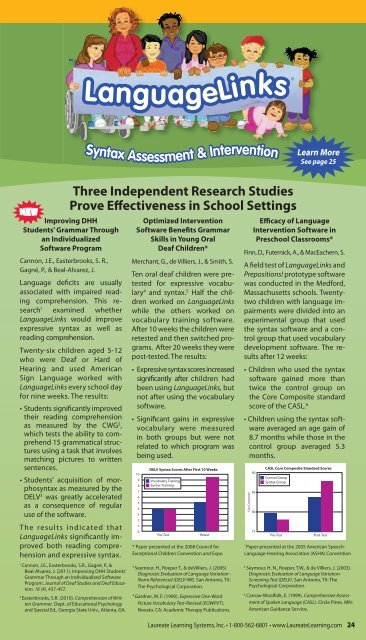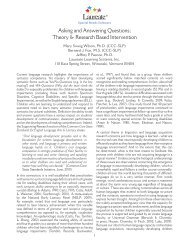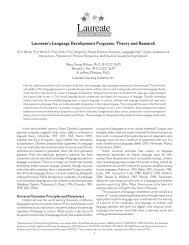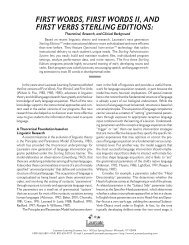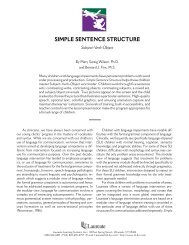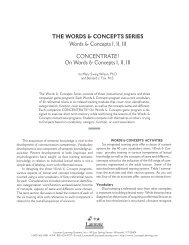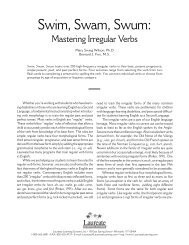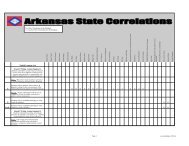Laureate Special Needs Software Catalog - Laureate Learning ...
Laureate Special Needs Software Catalog - Laureate Learning ...
Laureate Special Needs Software Catalog - Laureate Learning ...
You also want an ePaper? Increase the reach of your titles
YUMPU automatically turns print PDFs into web optimized ePapers that Google loves.
Three Independent Research Studies<br />
Prove E ectiveness in School Settings<br />
Improving DHH<br />
Students’ Grammar Through<br />
an Individualized<br />
<strong>Software</strong> Program<br />
Cannon, J.E., Easterbrooks, S. R.,<br />
Gagné, P., & Beal-Alvarez, J.<br />
Language defi cits are usually<br />
associated with impaired reading<br />
comprehension. This research1<br />
examined whether<br />
LanguageLinks would improve<br />
expressive syntax as well as<br />
reading comprehension.<br />
Twenty-six children aged 5-12<br />
who were Deaf or Hard of<br />
Hearing and used American<br />
Sign Language worked with<br />
LanguageLinks every school day<br />
for nine weeks. The results:<br />
• Students signifi cantly improved<br />
their reading comprehension<br />
as measured by the CWG2 ,<br />
which tests the ability to comprehend<br />
15 grammatical structures<br />
using a task that involves<br />
matching pictures to written<br />
sentences.<br />
• Students’ acquisition of morphosyntax<br />
as measured by the<br />
DELV3 was greatly accelerated<br />
as a consequence of regular<br />
use of the software.<br />
The results indicated that<br />
LanguageLinks signi cantly improved<br />
both reading comprehension<br />
and expressive syntax.<br />
Optimized Intervention<br />
<strong>Software</strong> Bene ts Grammar<br />
Skills in Young Oral<br />
Deaf Children*<br />
Merchant, G., de Villiers, J., & Smith, S.<br />
Ten oral deaf children were pretested<br />
for expressive vocabulary4<br />
and syntax. 5 Half the children<br />
worked on LanguageLinks<br />
while the others worked on<br />
vocabulary training software.<br />
After 10 weeks the children were<br />
retested and then switched programs.<br />
After 20 weeks they were<br />
post-tested. The results:<br />
• Expressive syntax scores increased<br />
signi cantly after children had<br />
been using LanguageLinks, but<br />
not after using the vocabulary<br />
software.<br />
• Signifi cant gains in expressive<br />
vocabulary were measured<br />
in both groups but were not<br />
related to which program was<br />
being used.<br />
10<br />
9<br />
8<br />
7<br />
6<br />
5<br />
4<br />
3<br />
2<br />
1<br />
0<br />
Core Composite<br />
75<br />
DELV Syntax Scores After First 10 Weeks<br />
Vocabulary Training<br />
Syntax Training<br />
Pre-Test<br />
* Paper presented at the 2008 Council for<br />
Exceptional Children Convention and Expo<br />
CASL Core Composite Standard Scores<br />
1 90<br />
Cannon, J.E., Easterbrooks, S.R., Gagné, P., &<br />
3 Seymour, Control H., Roeper Group T., & deVilliers, J. (2005)<br />
Beal-Alvarez, J. (2011). Improving DHH Students’<br />
Diagnostic Syntax Evaluation Group of Language Variation -<br />
Grammar Through an Individualized <strong>Software</strong><br />
Norm Referenced (DELV-NR). San Antonio, TX:<br />
Program. Journal of Deaf Studies and Deaf Educa- 85<br />
The Psychological Corporation.<br />
tion. 16 (4), 437-457.<br />
4<br />
2 Easterbrooks, S.R. (2010). Comprehension of Writ- Gardner, M. F. (1990). Expressive One-Word<br />
80<br />
ten Grammar. Dept. of Educational Psychology Picture Vocabulary Test-Revised (EOWPVT).<br />
and <strong>Special</strong> Ed., Georgia State Univ., Atlanta, GA.<br />
Novato, CA: Academic Therapy Publications.<br />
Retest<br />
®<br />
E cacy of Language<br />
Intervention <strong>Software</strong> in<br />
Preschool Classrooms*<br />
Finn, D., Futernick, A., & MacEachern, S.<br />
A eld test of LanguageLinks and<br />
Prepositions! prototype software<br />
was conducted in the Medford,<br />
Massachusetts schools. Twentytwo<br />
children with language impairments<br />
were divided into an<br />
experimental group that used<br />
the syntax software and a control<br />
group that used vocabulary<br />
development software. The results<br />
after 12 weeks:<br />
• Children who used the syntax<br />
software gained more than<br />
twice the control group on<br />
the Core Composite standard<br />
score of the CASL. 6<br />
DELV Syntax Scores After First 10 Weeks<br />
10<br />
9 Vocabulary Training<br />
8 Syntax Training<br />
7<br />
6<br />
5<br />
4<br />
• Children using the syntax soft-<br />
3<br />
ware 2 averaged an age gain of<br />
1<br />
8.7 months while those in the<br />
0<br />
Pre-Test<br />
Retest<br />
control group averaged 5.3<br />
months.<br />
Core Composite<br />
CASL Core Composite Standard Scores<br />
Control Group<br />
Syntax Group<br />
Pre-Test<br />
Post-Test<br />
<strong>Laureate</strong> Pre-Test <strong>Learning</strong> Systems, Post-Test Inc. • 1-800-562-6801 • www.<strong>Laureate</strong><strong>Learning</strong>.com 24<br />
90<br />
85<br />
80<br />
75<br />
* Paper presented at the 2005 American Speech-<br />
Language-Hearing Association (ASHA) Convention<br />
5 Seymour, H. N., Roeper, T.W., & de Villiers, J. (2003).<br />
Diagnostic Evaluation of Language Variation-<br />
Screening Test (DELV). San Antonio, TX: The<br />
Psychological Corporation.<br />
6 Carrow-Woolfolk, E. (1999). Comprehensive Assessment<br />
of Spoken Language (CASL). Circle Pines. MN:<br />
American Guidance Service.


